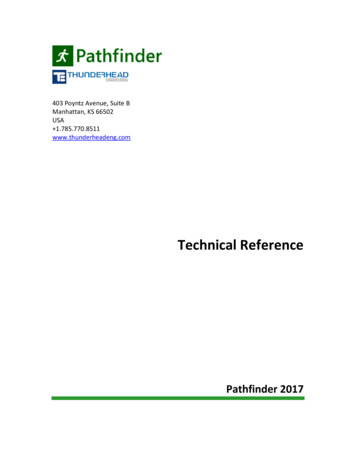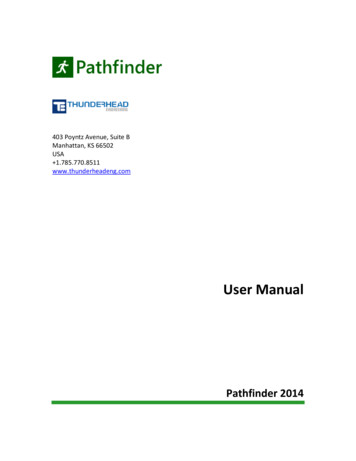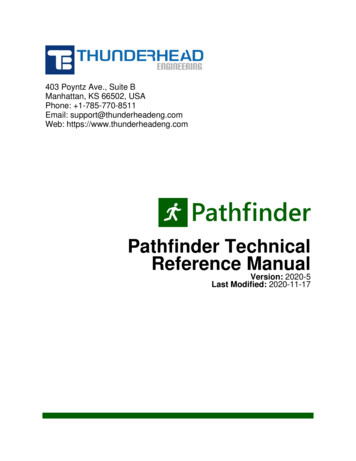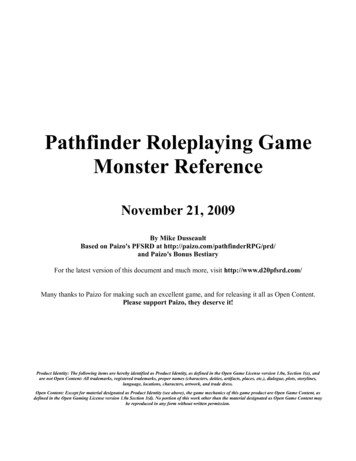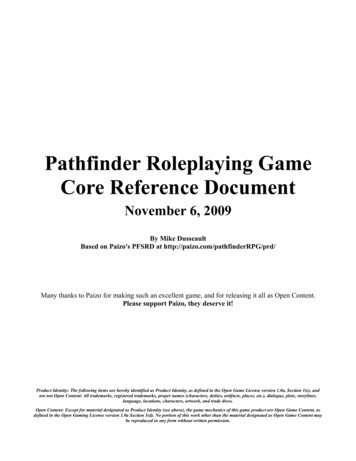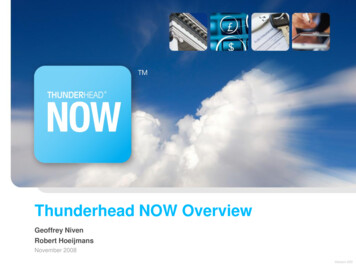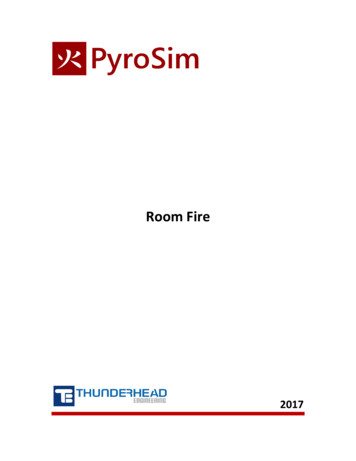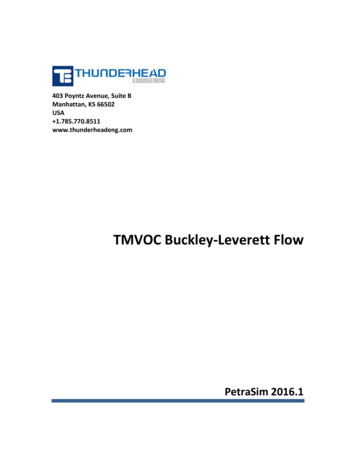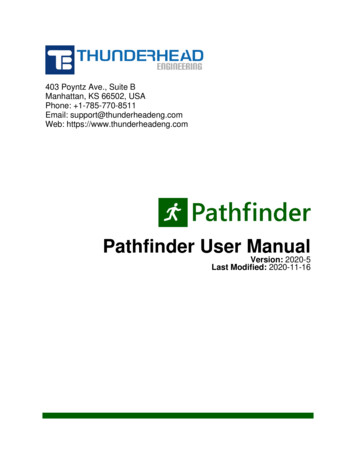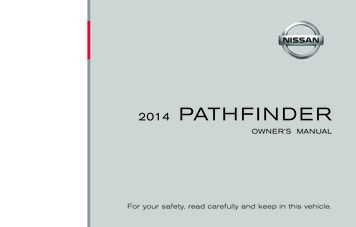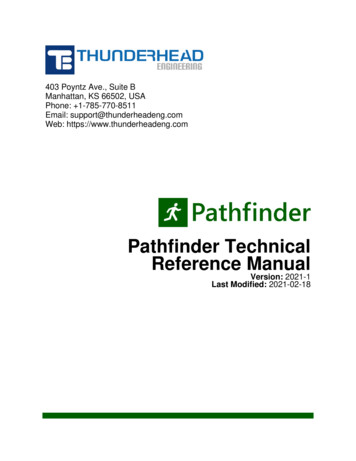
Transcription
403 Poyntz Ave., Suite BManhattan, KS 66502, USAPhone: 1-785-770-8511Email: support@thunderheadeng.comWeb: https://www.thunderheadeng.comPathfinder TechnicalReference ManualVersion: 2021-1Last Modified: 2021-02-18
Table of ContentsDisclaimer . . . . . . . . . . . . . . . . . . . . . . . . . . . . . . . . . . . . . . . . . . . . . . . . . . . . . . . . . . . . . . . . . . . . . . . . . . . . . . . . 2Acknowledgements . . . . . . . . . . . . . . . . . . . . . . . . . . . . . . . . . . . . . . . . . . . . . . . . . . . . . . . . . . . . . . . . . . . . . . . . 31. Overview . . . . . . . . . . . . . . . . . . . . . . . . . . . . . . . . . . . . . . . . . . . . . . . . . . . . . . . . . . . . . . . . . . . . . . . . . . . . . . . 41.1. Example Problem IMO Test 10 . . . . . . . . . . . . . . . . . . . . . . . . . . . . . . . . . . . . . . . . . . . . . . . . . . . . . . . . 42. Geometry . . . . . . . . . . . . . . . . . . . . . . . . . . . . . . . . . . . . . . . . . . . . . . . . . . . . . . . . . . . . . . . . . . . . . . . . . . . . . . . 82.1. Geometry Subdivision . . . . . . . . . . . . . . . . . . . . . . . . . . . . . . . . . . . . . . . . . . . . . . . . . . . . . . . . . . . . . . . 83. Behaviors and Goals . . . . . . . . . . . . . . . . . . . . . . . . . . . . . . . . . . . . . . . . . . . . . . . . . . . . . . . . . . . . . . . . . . . . 123.1. Idle Goals . . . . . . . . . . . . . . . . . . . . . . . . . . . . . . . . . . . . . . . . . . . . . . . . . . . . . . . . . . . . . . . . . . . . . . . . . . 123.2. Seek Goals . . . . . . . . . . . . . . . . . . . . . . . . . . . . . . . . . . . . . . . . . . . . . . . . . . . . . . . . . . . . . . . . . . . . . . . . . 123.3. Goals . . . . . . . . . . . . . . . . . . . . . . . . . . . . . . . . . . . . . . . . . . . . . . . . . . . . . . . . . . . . . . . . . . . . . . . . . . . . . . 134. Pathfinding . . . . . . . . . . . . . . . . . . . . . . . . . . . . . . . . . . . . . . . . . . . . . . . . . . . . . . . . . . . . . . . . . . . . . . . . . . . . 174.1. Path Planning . . . . . . . . . . . . . . . . . . . . . . . . . . . . . . . . . . . . . . . . . . . . . . . . . . . . . . . . . . . . . . . . . . . . . . 174.2. Path Generation . . . . . . . . . . . . . . . . . . . . . . . . . . . . . . . . . . . . . . . . . . . . . . . . . . . . . . . . . . . . . . . . . . . . 204.3. Path Following . . . . . . . . . . . . . . . . . . . . . . . . . . . . . . . . . . . . . . . . . . . . . . . . . . . . . . . . . . . . . . . . . . . . . 215. SFPE Mode. . . . . . . . . . . . . . . . . . . . . . . . . . . . . . . . . . . . . . . . . . . . . . . . . . . . . . . . . . . . . . . . . . . . . . . . . . . . . 235.1. SFPE Mode Parameters . . . . . . . . . . . . . . . . . . . . . . . . . . . . . . . . . . . . . . . . . . . . . . . . . . . . . . . . . . . . . 235.2. Velocity. . . . . . . . . . . . . . . . . . . . . . . . . . . . . . . . . . . . . . . . . . . . . . . . . . . . . . . . . . . . . . . . . . . . . . . . . . . . 245.3. Movement through Doors . . . . . . . . . . . . . . . . . . . . . . . . . . . . . . . . . . . . . . . . . . . . . . . . . . . . . . . . . . . 275.4. Collision Handling/Response . . . . . . . . . . . . . . . . . . . . . . . . . . . . . . . . . . . . . . . . . . . . . . . . . . . . . . . . 286. Steering Mode. . . . . . . . . . . . . . . . . . . . . . . . . . . . . . . . . . . . . . . . . . . . . . . . . . . . . . . . . . . . . . . . . . . . . . . . . . 296.1. Velocity. . . . . . . . . . . . . . . . . . . . . . . . . . . . . . . . . . . . . . . . . . . . . . . . . . . . . . . . . . . . . . . . . . . . . . . . . . . . 296.2. Acceleration . . . . . . . . . . . . . . . . . . . . . . . . . . . . . . . . . . . . . . . . . . . . . . . . . . . . . . . . . . . . . . . . . . . . . . . 296.3. Estimation of Occupant Density. . . . . . . . . . . . . . . . . . . . . . . . . . . . . . . . . . . . . . . . . . . . . . . . . . . . . . 306.4. Steering . . . . . . . . . . . . . . . . . . . . . . . . . . . . . . . . . . . . . . . . . . . . . . . . . . . . . . . . . . . . . . . . . . . . . . . . . . . 316.5. Evaluating Movement . . . . . . . . . . . . . . . . . . . . . . . . . . . . . . . . . . . . . . . . . . . . . . . . . . . . . . . . . . . . . . 386.6. Occupant States . . . . . . . . . . . . . . . . . . . . . . . . . . . . . . . . . . . . . . . . . . . . . . . . . . . . . . . . . . . . . . . . . . . . 386.7. Priority . . . . . . . . . . . . . . . . . . . . . . . . . . . . . . . . . . . . . . . . . . . . . . . . . . . . . . . . . . . . . . . . . . . . . . . . . . . . 406.8. Resolving Movement Conflicts . . . . . . . . . . . . . . . . . . . . . . . . . . . . . . . . . . . . . . . . . . . . . . . . . . . . . . . 406.9. Collision Avoidance/Response . . . . . . . . . . . . . . . . . . . . . . . . . . . . . . . . . . . . . . . . . . . . . . . . . . . . . . . 426.10. Movement through Doors . . . . . . . . . . . . . . . . . . . . . . . . . . . . . . . . . . . . . . . . . . . . . . . . . . . . . . . . . . 437. Vehicle Agents . . . . . . . . . . . . . . . . . . . . . . . . . . . . . . . . . . . . . . . . . . . . . . . . . . . . . . . . . . . . . . . . . . . . . . . . . 448. Assisted Evacuation . . . . . . . . . . . . . . . . . . . . . . . . . . . . . . . . . . . . . . . . . . . . . . . . . . . . . . . . . . . . . . . . . . . . 458.1. Assist Occupants Goal. . . . . . . . . . . . . . . . . . . . . . . . . . . . . . . . . . . . . . . . . . . . . . . . . . . . . . . . . . . . . . . 458.2. Wait for Assistance Goal . . . . . . . . . . . . . . . . . . . . . . . . . . . . . . . . . . . . . . . . . . . . . . . . . . . . . . . . . . . . 46
8.3. Coalition Formation Algorithm . . . . . . . . . . . . . . . . . . . . . . . . . . . . . . . . . . . . . . . . . . . . . . . . . . . . . . 479. Elevators . . . . . . . . . . . . . . . . . . . . . . . . . . . . . . . . . . . . . . . . . . . . . . . . . . . . . . . . . . . . . . . . . . . . . . . . . . . . . . 509.1. Idling. . . . . . . . . . . . . . . . . . . . . . . . . . . . . . . . . . . . . . . . . . . . . . . . . . . . . . . . . . . . . . . . . . . . . . . . . . . . . . 509.2. Pickup . . . . . . . . . . . . . . . . . . . . . . . . . . . . . . . . . . . . . . . . . . . . . . . . . . . . . . . . . . . . . . . . . . . . . . . . . . . . . 509.3. Discharge . . . . . . . . . . . . . . . . . . . . . . . . . . . . . . . . . . . . . . . . . . . . . . . . . . . . . . . . . . . . . . . . . . . . . . . . . . 5210. Solution Procedure . . . . . . . . . . . . . . . . . . . . . . . . . . . . . . . . . . . . . . . . . . . . . . . . . . . . . . . . . . . . . . . . . . . . 5311. Pathfinder Input File Format . . . . . . . . . . . . . . . . . . . . . . . . . . . . . . . . . . . . . . . . . . . . . . . . . . . . . . . . . . . 5411.1. NODES . . . . . . . . . . . . . . . . . . . . . . . . . . . . . . . . . . . . . . . . . . . . . . . . . . . . . . . . . . . . . . . . . . . . . . . . . . . 5411.2. VERTS . . . . . . . . . . . . . . . . . . . . . . . . . . . . . . . . . . . . . . . . . . . . . . . . . . . . . . . . . . . . . . . . . . . . . . . . . . . . 5411.3. NAVMESH NODES, VERTS . . . . . . . . . . . . . . . . . . . . . . . . . . . . . . . . . . . . . . . . . . . . . . . . . . . . . . . 5511.4. DOORS (optional) NODES . . . . . . . . . . . . . . . . . . . . . . . . . . . . . . . . . . . . . . . . . . . . . . . . . . . . . . . . 5511.5. EDGES (optional) . . . . . . . . . . . . . . . . . . . . . . . . . . . . . . . . . . . . . . . . . . . . . . . . . . . . . . . . . . . . . . . . . . 5611.6. PARAM (optional) . . . . . . . . . . . . . . . . . . . . . . . . . . . . . . . . . . . . . . . . . . . . . . . . . . . . . . . . . . . . . . . . . 5711.7. EVENTS . . . . . . . . . . . . . . . . . . . . . . . . . . . . . . . . . . . . . . . . . . . . . . . . . . . . . . . . . . . . . . . . . . . . . . . . . . 5911.8. BEHAVIORS . . . . . . . . . . . . . . . . . . . . . . . . . . . . . . . . . . . . . . . . . . . . . . . . . . . . . . . . . . . . . . . . . . . . . . . 6011.9. PROFILES. . . . . . . . . . . . . . . . . . . . . . . . . . . . . . . . . . . . . . . . . . . . . . . . . . . . . . . . . . . . . . . . . . . . . . . . . 6111.10. FUNCTIONS. . . . . . . . . . . . . . . . . . . . . . . . . . . . . . . . . . . . . . . . . . . . . . . . . . . . . . . . . . . . . . . . . . . . . . 6411.11. DISTRIBUTIONS . . . . . . . . . . . . . . . . . . . . . . . . . . . . . . . . . . . . . . . . . . . . . . . . . . . . . . . . . . . . . . . . . . 6511.12. COMPONENT RESTRICTIONS . . . . . . . . . . . . . . . . . . . . . . . . . . . . . . . . . . . . . . . . . . . . . . . . . . . . . . 6711.13. OCCUPANT SHAPES . . . . . . . . . . . . . . . . . . . . . . . . . . . . . . . . . . . . . . . . . . . . . . . . . . . . . . . . . . . . . . 6711.14. ASSISTED EVACUATION TEAMS. . . . . . . . . . . . . . . . . . . . . . . . . . . . . . . . . . . . . . . . . . . . . . . . . . . . 6911.15. OCCUPANT SOURCES . . . . . . . . . . . . . . . . . . . . . . . . . . . . . . . . . . . . . . . . . . . . . . . . . . . . . . . . . . . . . 6911.16. TAGS . . . . . . . . . . . . . . . . . . . . . . . . . . . . . . . . . . . . . . . . . . . . . . . . . . . . . . . . . . . . . . . . . . . . . . . . . . . . 7011.17. OCCUPANTS . . . . . . . . . . . . . . . . . . . . . . . . . . . . . . . . . . . . . . . . . . . . . . . . . . . . . . . . . . . . . . . . . . . . . 7111.18. ELEVATORS . . . . . . . . . . . . . . . . . . . . . . . . . . . . . . . . . . . . . . . . . . . . . . . . . . . . . . . . . . . . . . . . . . . . . . 7211.19. OTHER NOTES . . . . . . . . . . . . . . . . . . . . . . . . . . . . . . . . . . . . . . . . . . . . . . . . . . . . . . . . . . . . . . . . . . . 7412. View File Format . . . . . . . . . . . . . . . . . . . . . . . . . . . . . . . . . . . . . . . . . . . . . . . . . . . . . . . . . . . . . . . . . . . . . . 7613. Occupant Slowing In Smoke . . . . . . . . . . . . . . . . . . . . . . . . . . . . . . . . . . . . . . . . . . . . . . . . . . . . . . . . . . . . 7814. Fractional Effective Dose (FED) . . . . . . . . . . . . . . . . . . . . . . . . . . . . . . . . . . . . . . . . . . . . . . . . . . . . . . . . . 7915. Calculation of Measurement Region Quantities . . . . . . . . . . . . . . . . . . . . . . . . . . . . . . . . . . . . . . . . . . 81Bibliography . . . . . . . . . . . . . . . . . . . . . . . . . . . . . . . . . . . . . . . . . . . . . . . . . . . . . . . . . . . . . . . . . . . . . . . . . . . . . 82
Pathfinder - Technical Reference ManualDisclaimerThunderhead Engineering makes no warranty, expressed or implied, to users of Pathfinder, andaccepts no responsibility for its use. Users of Pathfinder assume sole responsibility under Federallaw for determining the appropriateness of its use in any particular application; for anyconclusions drawn from the results of its use; and for any actions taken or not taken as a result ofanalyses performed using these tools.Users are warned that Pathfinder is intended for use only by those competent in the field of egressmodeling. Pathfinder is intended only to supplement the informed judgment of the qualified user.The software package is a computer model that may or may not have predictive capability whenapplied to a specific set of factual circumstances. Lack of accurate predictions by the model couldlead to erroneous conclusions. All results should be evaluated by an informed user.All other product or company names that are mentioned in this publication are tradenames,trademarks, or registered trademarks of their respective owners.Throughout this document, the mention of computer hardware or commercial software does notconstitute endorsement by Thunderhead Engineering, nor does it indicate that the products arenecessarily those best suited for the intended purpose.Disclaimer2
Pathfinder - Technical Reference ManualAcknowledgementsThis work was partially funded by a Small Business Innovative Research (SBIR) grant by theUnited States National Science Foundation (NSF).We would like to thank Rolf Jensen and Associates for their assistance with testing and othersuggestions that helped guide the development of the simulator.In addition, we would like to thank all the beta testers who contributed feedback on the webforums and via email.3Acknowledgements
Pathfinder - Technical Reference ManualChapter 1. OverviewPathfinder is an agent-based egress simulator that uses steering behaviors to model occupantmotion. It consists of three modules: a graphical user interface, the simulator, and a 3D resultsviewer.Pathfinder provides two primary options for occupant motion, SFPE mode and Steering mode.SFPE mode (Chapter 5)Implements the concepts in the SFPE Handbook of Fire Protection Engineering (SFPE 2016).This is a flow model, where walking speeds are determined by occupant density within eachroom and flow through doors is controlled by door width.Steering mode (Chapter 6)Based on the idea of inverse steering behaviors. Steering behaviors were first presented inCraig Reinolds' paper "Steering Behaviors For Autonomous Characters" (Reinolds 1999) andlater refined into inverse steering behaviors in a paper by Heni Ben Amor (Amor et al. 2006).Pathfinder’s steering mode allows more complex behavior to naturally emerge as a byproductof the movement algorithms - eliminating the need for explicit door queues and densitycalculations.Pathfinder is included in the NIST Review of Evacuation Models (Kuligowski, Peacock, andHoskins 2010), but the most current set of features and capabilities may not be reflected in thatdocument.1.1. Example Problem IMO Test 10In the following discussions, it is often useful to have an example with which to illustrateparticular points. One frequently referenced example is Test 10 from the International MaritimeOrganization (IMO) (IMO 2016).This test problem represents a cabin corridor section as shown in Figure 1, the cabins arepopulated as indicated. The population consists of males 30-50 years old with a minimum walkingspeed of 0.97 m/s, a mean speed of 1.30 m/s, and a maximum speed of 1.62 m/s. There is no delayin response and the walking speeds are distributed uniformly between the minimum andmaximum to the 23 occupants. The passengers in cabins 5 and 6 are assigned the secondary exit;all the remaining passengers use the main exit. The expected result is that the allocatedpassengers move to the appropriate exits.Chapter 1. Overview4
Pathfinder - Technical Reference ManualFigure 1. Cabin area (from IMO, 2002)The display of occupant movement, Figure 2, does show that occupants have selected the assignedexits. In this display, the paths of all occupants are displayed, with selected occupants and theirpaths highlighted. For the steering mode analysis, all occupants exited the corridor in 18.0seconds.The results for SFPE mode are illustrated in Figure 3. In SFPE mode, the passengers form a queueat the main exit and the flow through this door controls the exit time. For the SFPE analysis, alloccupants exited in 21.2 seconds. In SFPE mode, occupants can overlap in space during movementand when the queue forms.5Chapter 1. Overview
Pathfinder - Technical Reference ManualFigure 2. Steering mode results for IMO 10 problem showing occupant movement, note howhighlighted occupants move to their assigned exits.Chapter 1. Overview6
Pathfinder - Technical Reference ManualFigure 3. SFPE mode result for IMO 10 problem, note that multiple occupants can occupy the samespace.7Chapter 1. Overview
Pathfinder - Technical Reference ManualChapter 2. GeometryPathfinder uses a 3D geometry model (Figure 4). Within this geometric model is a navigation meshdefined as a continuous 2D triangulated surface referred to as a "navigation mesh". Thenavigation mesh is an irregular one-sided surface represented by adjacent triangles. Occupantmotion takes place within the boundaries of this navigation mesh.Figure 4 shows a townhouse model and the corresponding navigation mesh in Figure 5.Pathfinder supports drawing or automatic generation of a navigation mesh from importedgeometry – including Fire Dynamics Simulator (FDS) files, PyroSim files, and a collection of othercommon CAD file formats.Figure 4. 3D geometryFigure 5. Extracted navigation meshAs can be seen in Figure 5, obstructions in Pathfinder are represented implicitly as gaps in thenavigation mesh. Since occupants can only travel on the navigation mesh, this technique preventsthe overhead of any solid object representation from affecting the simulator. When the navigationmesh is generated by importing geometry, any region of the mesh blocked by a solid object isautomatically removed. For overhead obstructions, the mesh generator considers any obstructionwithin 1.8 meters (6 feet) of the floor to be an obstacle.2.1. Geometry SubdivisionThe navigation geometry is organized into rooms of irregular shape. Each room has interior(optional) and exterior boundaries that cannot be crossed by an occupant.Travel between two adjacent rooms is through connecting doors. A door that does not connect twoChapter 2. Geometry8
Pathfinder - Technical Reference Manualrooms and is defined on the exterior boundary of a room is an exit door. There can be multipleexit doors in a model. When an occupant enters an exit door in SFPE mode, they are queued at thedoor and removed at the flow rate defined by SFPE. Occupants that enter an exit door in reactivesteering mode are removed from the simulation immediately.Figure 6 illustrates these concepts for the IMO Test 10 problem. The rooms (and corridors) areshaded different colors. Doors from individual rooms to the corridor (just another room in themodel) are indicated by a thick orange line. Exit doors are indicated by a thick light green line.Occupants are shown by the blue dots. Superimposed on the geometry is the navigation mesh.Figure 6. Rooms, doors, exits and the navigable mesh in the IMO Test 10 problemAny location on the navigation mesh can be categorized as one of four terrain types: open space,stairs, doors and exit. Ramps and rooms are both classified as open space. Each terrain type hasan effect on the behavior of occupants on that section of the mesh.2.1.1. RoomsThe open space within a Room provides no explicit constraints on movement. Rooms created inthe user interface using the room drawing tools are all considered open space having level9Chapter 2. Geometry
Pathfinder - Technical Reference Manualterrain, even if rotated so that they have slope. In SFPE mode, the maximum walking speed ofoccupants becomes a function of the occupant density in the room.While a room may be rotated such that it resembles a ramp, it is still a room andNOTEis considered to be level terrain in the speed calculations. The only way to create aramp in the user interface is to use one of the ramp drawing tools.2.1.2. StairsStairways connect rooms on different levels. They denote areas where the maximum occupantvelocity is controlled by an alternate calculation specific to stairways. The specific velocitycalculation is given in the stairway section for each simulator mode.At the top and base of each stairway, there are two doors. While the user can edit the width andactivation events for the doors, the doors cannot be directly moved or deleted independently ofthe stair. These doors connect the stairway mesh to the adjacent rooms' meshes and functionidentically to ordinary connecting doors.Like doors, stairs can normally be traversed in either direction, but they can also be marked asone-way. The simulator models this by making both doors on the ends of the stair one-way.Each stair has associated step rise and step run properties, which are settable in the userinterface. This rise/run does not have to match the geometric slope of the stair. This is importantas it relates to the calculation of an occupant’s speed on stairs as discussed in Section 5.2.2.1.3. RampsRamps are created and represented
Feb 18, 2021 · Throughout this document, the mention of computer hardware or commercial software does not constitute endorsement by Thunderhead Engineering, nor does it indicate that the products are necessarily t
